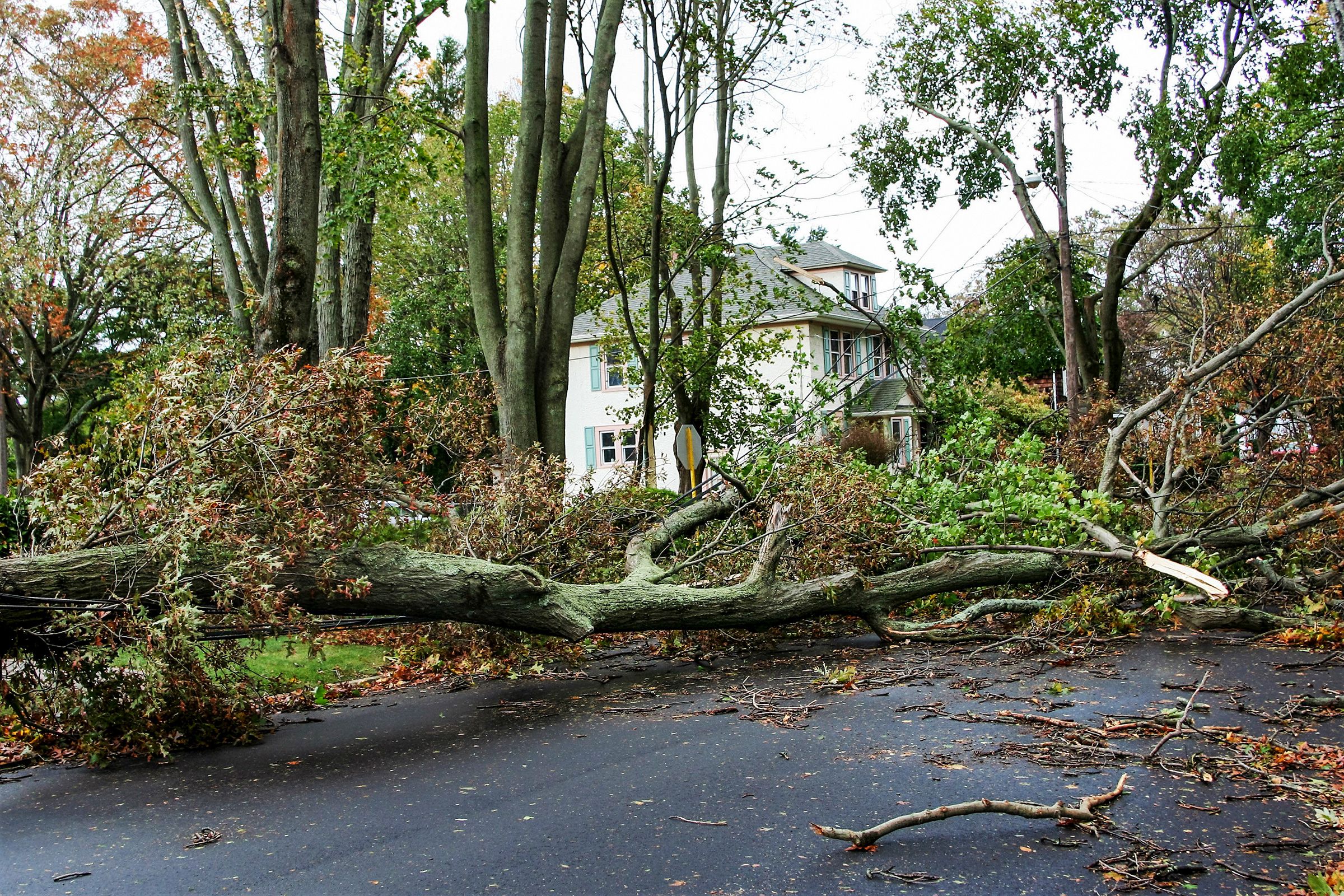Hurricanes pose a significant threat to homes along the Eastern seaboard and Gulf Coast, but with proper preparation, you can greatly improve your home’s chances of weathering the storm. This comprehensive guide will walk you through essential steps to protect your home, family, and belongings from hurricane damage. By following this checklist, you’ll be better equipped to face the challenges that come with hurricane season.
Hurricane Roof Protection

As the air pressure drops and hurricane winds flow around and over a building, this can create a powerful upward force, called wind uplift. If shingles or other roofing materials are not securely attached, they will simply peel off, opening avenues for water to infiltrate. In the worst-case scenario, roof sheathing pulls off too, compromising the house’s structural integrity while exposing the inside to the elements. Here are some steps you can take to combat this.
Brace Gable Roofs
A hip roof, in which four sides slope toward a central ridgeline, are naturally more wind-resistant than a gable roof, which only has two sides that slope to a center peak. One way to strengthen a gable roof is to brace the end walls, which are the most vulnerable to wind uplift.
Get up into the attic and nail or screw a pair of 2x4s in an “X” pattern—one extending from the peak of the gable to the bottom center brace of the fourth truss, and the other from the bottom center of the gable to the top center brace of the fourth truss. Use 3-inch-long wood screws with a ¼-inch-diameter shank, or 16d galvanized common nails, and reinforce the new braces wherever they meet roof members with one-inch galvanized-steel straps.
If your roof is framed with rafters, you can strengthen it by adding collar ties. “Adding collars will improve a roof’s ability to take wind load,” says John Knezevich of Thornton-Tomasetti Group Engineering, in Fort Lauderdale, Florida. Brace every pair of rafters by running a long stud from one side of the roof to the other, three-quarters of the way up the slope of the rafters (imagine the letter “A”). Fasten it at each end with long wood screws and galvanized-steel straps, effectively creating a bridge across the inside of the roof. These are a few different ways to protect your roof in a storm.
Add Adhesive Reinforcement
Go into the attic and run a half-inch bead of construction adhesive along each rafter or truss where it meets the plywood roof sheathing above. “A good, thick bead down the edge on both sides of the rafter will tighten everything right up,” says This Old House general contractor Tom Silva. This simple step will roughly triple a roof’s protection against being torn off by the wind.
Strengthen with Strapping
Hurricane straps—one-inch-wide galvanized steel ties that extend from the stud to the top plate and over the truss or rafter—tie the roof and walls together. While it’s not easy to retrofit them (there’s little maneuvering room in the attic at the edge of a pitched roof), it can be done by a skilled professional, who may need to remove a section of roof sheathing or siding to gain access. Attach a strap at each roof-to-wall connection.
Upgrade with a Permanent Solution
For new construction or an addition, the roof should be built to wind-rating codes for your area, with 5/8-inch plywood decking fastened securely to the roof framing. If you have an older house, you can waterproof the seams with self-adhering flashing tape, cover the sheathing with roofing felt, and top the whole thing off with architectural shingles rated for wind and impact resistance. Typically, these special shingles are laminated sandwiches of fiberglass and asphalt, held down by six nails in a special pattern. In addition, glue down all shingles within two feet of the roof’s vulnerable outer edges with an asphalt cement.
Hurricane Window Protection
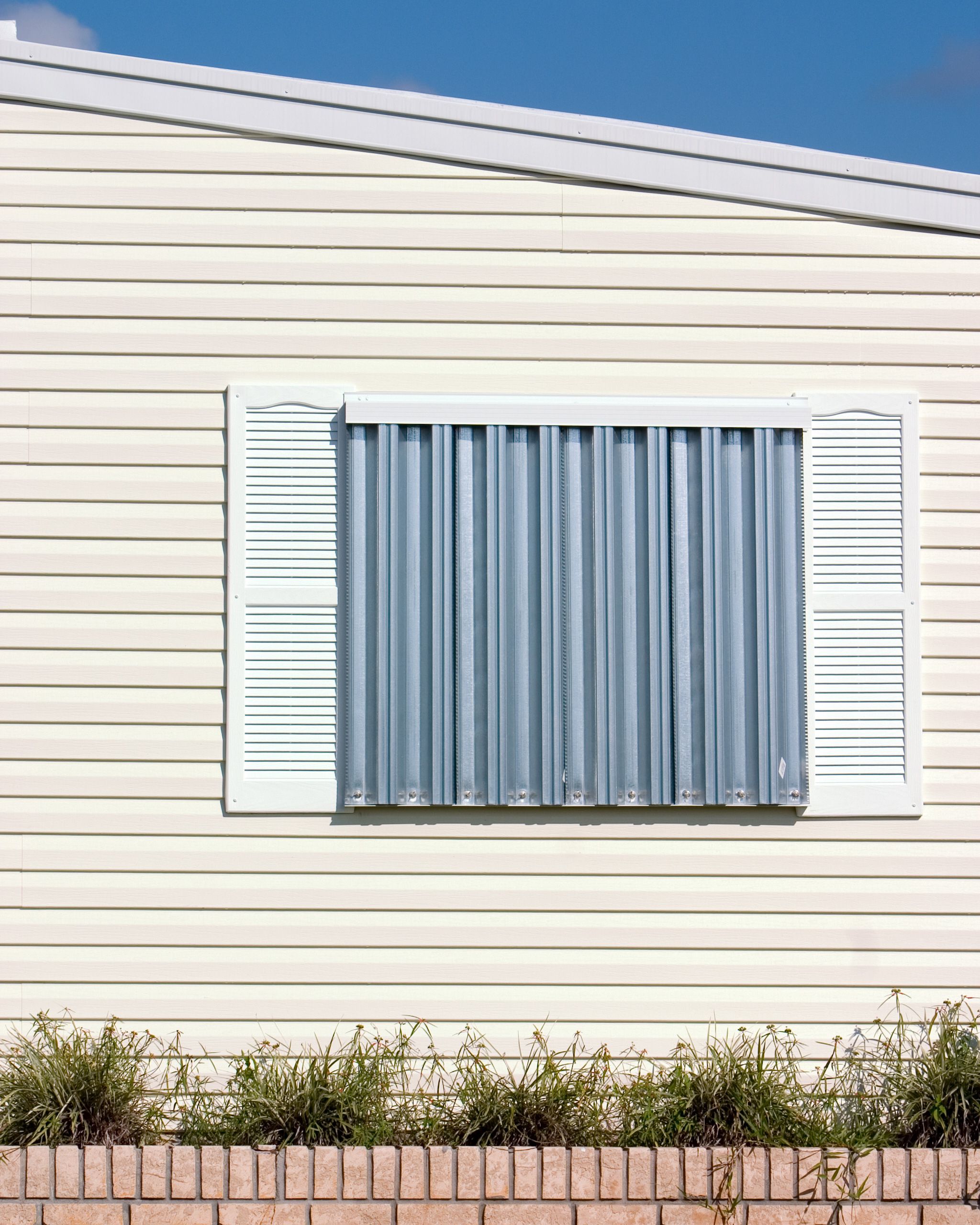
High winds and flying debris can smash unprotected windows, setting off the catastrophic phenomenon known as internal pressurization. “The wind comes in through a broken window or failed door, and it’s gotta come back out,” explains Leslie Chapman-Henderson, CEO of the Federal Alliance for Safe Homes, a coalition of insurance firms, private corporations, and government agencies. “The pressure will build, and it will literally explode out whatever weak spots it finds in your structure.” Protect your windows with storm shutters made of steel, aluminum, or high-strength polycarbonate plastic; there are dozens of companies that manufacture shutters. Here are the most common ways to shield your windows.
Install Aluminum Panels
These interlocking corrugated metal panels slide into a pre-mounted track and attach with wing nuts. The permanent track can be painted to match the house’s exterior. Panels provide solid protection against debris and wind, but they’re tough to handle (mind the sharp edges!), bulky to store, and time-consuming to install, especially on upper floors. For a typical family home, two people should allow at least a half day to mount them.
Add Fabric Shields
These PVC-coated polyester fabric panels don’t offer the same degree of protection as steel or aluminum, but they do meet Florida Building Code standards. And unlike metal shutters, they’re easy to handle and store, and won’t leave your home in total darkness. “The fabric shields allow enough light in that it looks like your mini blinds are closed,” says Mike George, a spokesman for manufacturer Wayne Dalton.
Mount Colonial Shutters
Along with Bahama-style shutters, which swing down to cover a window from the top, these permanent swing-out shutters, available in aluminum or fiberglass, combine protection and convenience with architectural style. When a storm approaches, just pull them closed and latch them securely. You can usually do this from inside the house, which means no perilous work atop ladders. The downside: They’re expensive.
Install Roll-Down Shutters
When not in use, steel roll-downs retract into a housing above or beside the window. They can be operated manually or automatically. If you opt for motorized, remember to install a battery backup. It can cost tens of thousands of dollars to hire a pro to equip a 2,000-square-foot house with the fully automated variety.
Upgrade With a Permanent Solution
If you’re buying all new windows, you can choose impact windows tested to one of the major standards. Available from most leading manufacturers, these consist of a layer of plastic sandwiched between two pieces of glass. “Impact windows are similar to your car’s windshield, but quite a bit thicker,” says Steve Berg, coastal products manager for Andersen Windows.
The super-strong glass may crack if hit hard enough by flying debris, but the bonded plastic interlayer will keep the pane intact and keep the wind out. Impact windows come in a variety of styles, including historically accurate double-hungs. Expect to pay substantially more for an impact-resistant insulated hurricane window than for the conventional-strength variety. The cost of hurricane-impact window installation for an entire home averages about $12,000, according to Angi, but varies depending on the size and number of windows and the materials.
If you buy new windows or doors for use in a hurricane region, you can rest easy knowing that they will have already taken some serious hits in the lab. That’s because building envelope products—roofing, windows, doors, and so on—sold in so-called high-velocity wind zones are required to meet stringent ASTM International standards for wind pressurization and debris impact.
To determine if the goods are up to snuff, independent testing facilities simulate a hurricane’s fury. To test how well impact windows perform, for instance, technicians fire a nine-pound 2×4 out of an air cannon at 50 feet per second. Should the wooden missile penetrate or significantly crack the window, then it’s back to the drawing board for the manufacturer.
Hurricane Protection for Garage & Entry Doors
If your home has an attached garage, think of that wide, roll-up door as a welcome mat for a hurricane. When 74-plus-mph winds hit the relatively thin aluminum panels of a standard door, typically, that door buckles and fails, allowing pressure to build up inside the house until it blows apart.
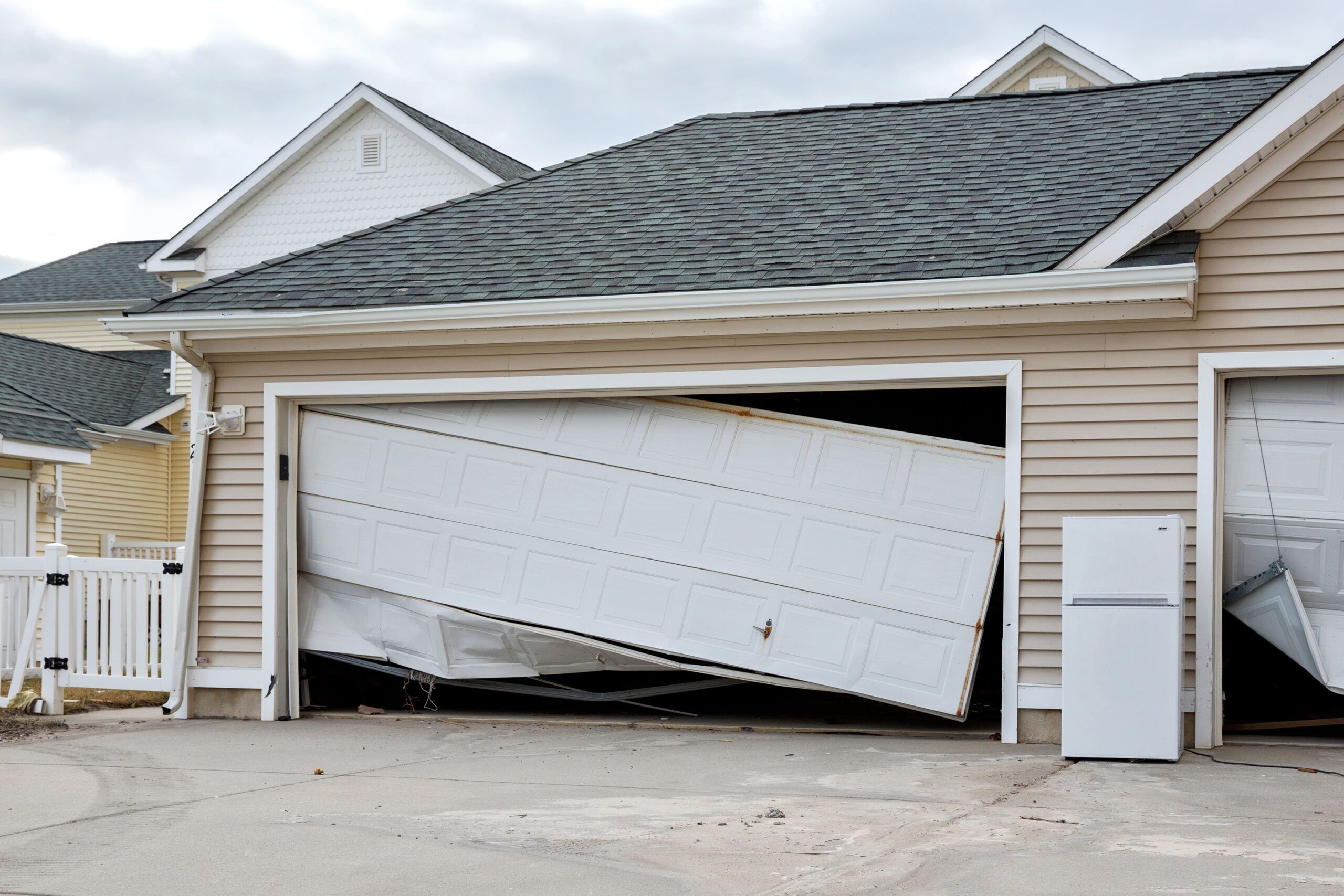
“More than 90% of the time, the garage door is the first thing to go,” says Chapman-Henderson. Fortunately, it’s also one of the easiest parts of the house to strengthen against blow-in. The same is true of double-entry doors: Without adequate reinforcing, they can potentially blow in or be pulled off.
Add a Removable Bracing System
Temporary reinforcing posts to strengthen your garage door will improve your chances against a blow-in or pull-off.
Beef Up Door Hardware
For double-entry doors, some simple hardware changes are all it takes to dramatically improve the strength. For starters, replace hinge screws with longer versions that extend all the way through the surrounding framing. Change out the standard deadbolt for a longer-throw version and add deadbolts on top and bottom.
Multiple-point locking systems have two or more internal deadbolts, giving you added protection without compromising looks. Finally, add vertical locking pins to the top and bottom of the moveable door; in a traditional setup, only the stationary door has them. Make sure the lower pin extends down into concrete or solid wood.
Single-entry doors are slightly less susceptible to blowing in, but an object sent hurtling toward the front door could break the jamb. Homes in hurricane-prone areas should consider reinforcing their jambs. Reinforcement kits include long steel plates that are installed inside the door jamb, significantly improving the jamb’s strength. Should a heavy object hit the door, the jamb may crack but the plate will stay intact, preventing the door from blowing inward.
Upgrade with a Permanent Solution
Replace garage and entry doors with storm-rated models. For garage doors, that means braced steel construction with heavy-duty rollers, hinges, and tracks, and additional track-attachment points. Reinforced entry doors typically are made of fiberglass, steel, or solid wood with impact glazing. Prices range from a few hundred dollars for steel to several thousand for top-of-the-line fiberglass.
Hurricane Protection for Trees

When the ground is saturated by a flood or heavy rain, poorly rooted or sited trees can blow over onto your house or power lines, and dead branches can snap off and become airborne missiles. Here are a few things you can do to prepare.
Prune and Brace Trees
Well-pruned trees will weather a bad storm far better than those that are simply left to grow unattended. Structural pruning, particularly in a tree’s early years, can prevent it from developing competing trunks (called “co-dominant leaders”) that grow alongside each other from a central point. “That’s like the San Andreas Fault waiting to open up the next time there’s a big wind,” says horticulturist Charles Livio, vice president of the Landscape Inspector’s Association of Florida. “The trees just split in half.”
Prune mature trees so that wind can blow through the canopy of leaves, not against it. “Very dense foliage presents a sail effect,” Livio explains. As for fruit trees, pick the fruit before a storm, if possible. “That will lighten the load and reduce the risk of projectiles,” Livio says.
Finally, brace younger trees in advance of a storm with stranded nylon rope and 3-foot-long sections of number four or number six rebar, or wood stakes pounded into the ground at 45-degree angles away from the trunk. Be sure to remove the stakes and ropes after the danger passes.
Upgrade with a Permanent Solution
If you’re establishing a new landscape, plant well-rooted varieties of trees, which tend to be slower-growing species with smaller leaves. Ask a local nursery for wind-tolerant choices, but good bets include live oak, beech, Indian tamarind, and bald cypress.
“Slower-growing trees tend to have stronger wood,” says Livio. Proper planting techniques help trees develop a strong root system, says This Old House landscape contractor Roger Cook. Avoid planting a large tree in a small area, such as a narrow strip alongside a driveway. If the roots are constrained, they can’t get a good purchase in the soil, increasing the chance of a blowdown.
Hurricane Home Infrastructure Protection
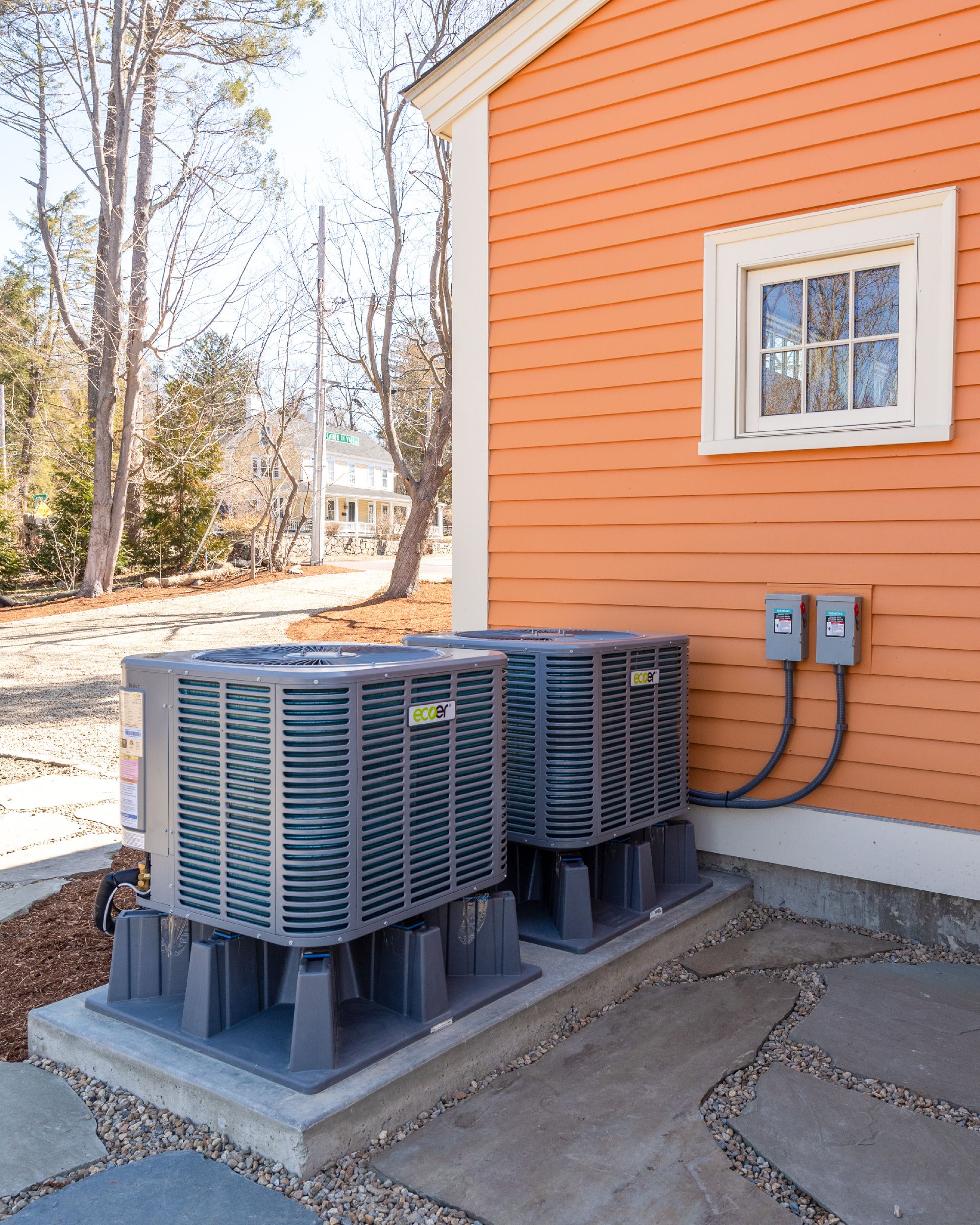
There are things you can do for your home’s infrastructure or critical systems that can help them weather a hurricane and reduce the repairs when it’s over. This includes items like outdoor HVAC units and electrical systems.
Raise the HVAC
Most folks have outdoor HVAC units that sit directly on concrete slabs, and those slabs are just one to three inches above grade. If hurricane-caused flooding occurs, those units are immediately in the path of the flood waters. This can lead to damage or ripping the units right off their bases.
Rather than saying “see ya” to your AC, consider elevating it. This would involve building taller pads that lift them above potential flood waters, which will help them stay put longer (and in better condition) than if they’re built on grade.
Survey Electrical Utilities
As time goes on, electrical poles can shift, and the tensions on those wires connected to the poles can change. With enough time, lines can sag while others become very tight, and even start to pull on the connection to a home. A well-timed hurricane can take advantage of those lines and cause them to snap, tear from a home, or simply touch things that power lines shouldn’t touch.
Head outside and survey the electrical service to your home and the homes around yours. If the lines seem exceptionally slack (they will sag during hot weather and during high-use hours) or overly taught, it might be time to call the utility company in to take a look.
Perform Regular Inspections
Foundations can outlive the homes that sit on them, but that doesn’t mean we should forget about them. Excessive cracking, shifting, or deteriorating concrete can cause structural issues that a hurricane will only worsen.
Perform regular maintenance on your foundation. Repair cracks and maintain a protective coat of paint on the surface. Have any structural damage surveyed by a structural engineer so they can help you come up with the appropriate plan to fix them as well. This will ensure your foundation is strong and stable, and that it can weather any storm.
Hurricane Ground-Level Considerations
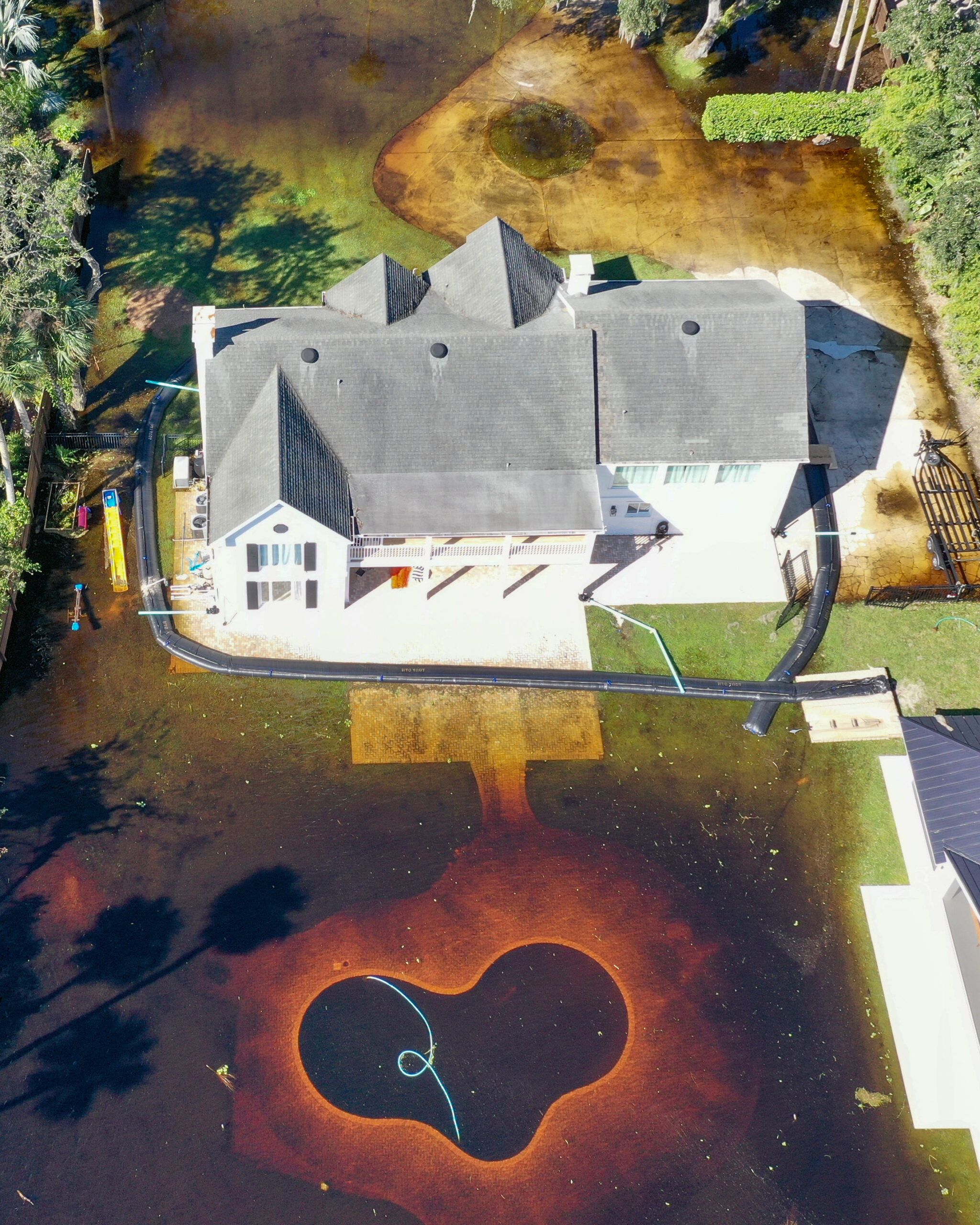
While we’re typically focused on roofing, windows, doors, and trees, the items below are no less important.
Install Flood Vents
Many homes in hurricane-prone states sit on crawl spaces. Water pressure on the side of a crawl space creates hydrostatic pressure, which can push a home and shift its foundation, or worse. Luckily, there is a way (and it’s rather permanent) to prevent this and equalize pressure when flood waters rise: flood vents.
Flood vents are essentially gaps in the foundation that allow water into the crawlspace. This allows the water inside and outside to equalize in pressure, making the entire structure more stable and limiting shifting and damage until the water levels recede.
Swap Out Gravel
Gravel can be an excellent architectural element, but a handful of gravel can also become a hail of bullets if the wind is strong enough to pick it up. Whether it’s a gravel driveway, stone mulch beds, or anywhere in between, it might be time to make the switch to another material.
Rather than gravel, crushed stone, or other small rocks, consider using mulch or rubber mulch. Should a hurricane pick up a handful of rubber mulch, it’s far less likely to do damage to a home, vehicle, or person than a stone.
Drain the Pool
Even landscape features like the pool can pose a problem. If flooding causes it to overflow, the chlorinated water can damage plants and grass, so remember to lower the water level in advance of the storm.
Tie Down Decor and Vehicles
It’s not just trees and shrubs that can cause damage in a hurricane. Items left outside that aren’t permanently rooted to the ground can wash away or be picked up or knocked over. Follow these guidelines for each type of item.
Anchor Boats, RVs, and Trailers in the Driveway
Those recreational vehicles might be a lot of fun when they’re in use, but they’re a serious liability during a hurricane. They can float away, careen into the house, or even topple over.
FEMA suggests anchoring boats, RVs, and trailers into the ground. This might look like pouring a concrete footing or two into the ground near the trailer and installing an anchor in the concrete before it dries. A chain or strap hooking these vehicles to the anchor should keep them in place through the storm. Installing two footings underneath the trailer will allow the homeowner to secure the trailer and prevent it from tipping, if that is the concern.
Move Patio Furniture
Without proper care, patio furniture is essentially a goner in a hurricane. Outdoor tables and chairs are often light to make them easy enough to move indoors or out, but when hurricane winds pick up, they can fly into your home or a neighbor’s in an instant.
The best move is to bring any patio furniture inside a garage or basement where it can be secure. If that’s not possible, consider weaving a ratchet strap through each of the pieces of furniture and cinching it down around a deck pole or sturdy handrail for safekeeping until the storm passes through.
Secure Toys and Playsets
Like patio furniture, playsets and yard toys can become airborne threats. The plastics they’re made from are safe for children to play on, but they easily cause siding damage or even break windows, allowing rain to make its way into the home.
Bring the toys into the garage, if possible, or set them up in a basement or another safe place so kids can occupy themselves if you’re sheltering in place. If moving them inside isn’t an option, strap them to a deck post, fence post, or other strong, sturdy item anchored into the ground. The idea is not to save the toys from disappearing but to keep them from becoming airborne debris that can cause damage or injury.
Evaluate Landscaping for Flood Resistance
Assess your property’s ability to handle heavy rainfall:
- Ensure proper grading to direct water away from your home.
- Consider installing a rain garden or bioswale to manage excess water.
- Use permeable materials for driveways and walkways to improve drainage.
- Adding French drains can provide additional channels for water to disperse safely away from your home.
- Plant native vegetation that can absorb significant amounts of water and assist in reducing runoff. Use mulch in your garden beds to keep the soil moisture content balanced and reduce erosion.
Step Up on Hurricane Safety Gear
Make sure you have all the necessary supplies: cellphone and charger, flashlight, extra batteries, first-aid kit, a whistle to signal for help, medication, a multi-purpose tool (like a Swiss Army knife). And in the better-safe-than-sorry department, it’s also a good idea to have wipes, hand sanitizer, garbage bags and ties on hand for personal sanitation, if needed. In case you have to leave in a hurry, have a to-go bag at the ready that has other items like cash, passports, bank information, emergency contacts, and other important documents packed in a waterproof container. Check the FEMA site for a list of other key essentials.
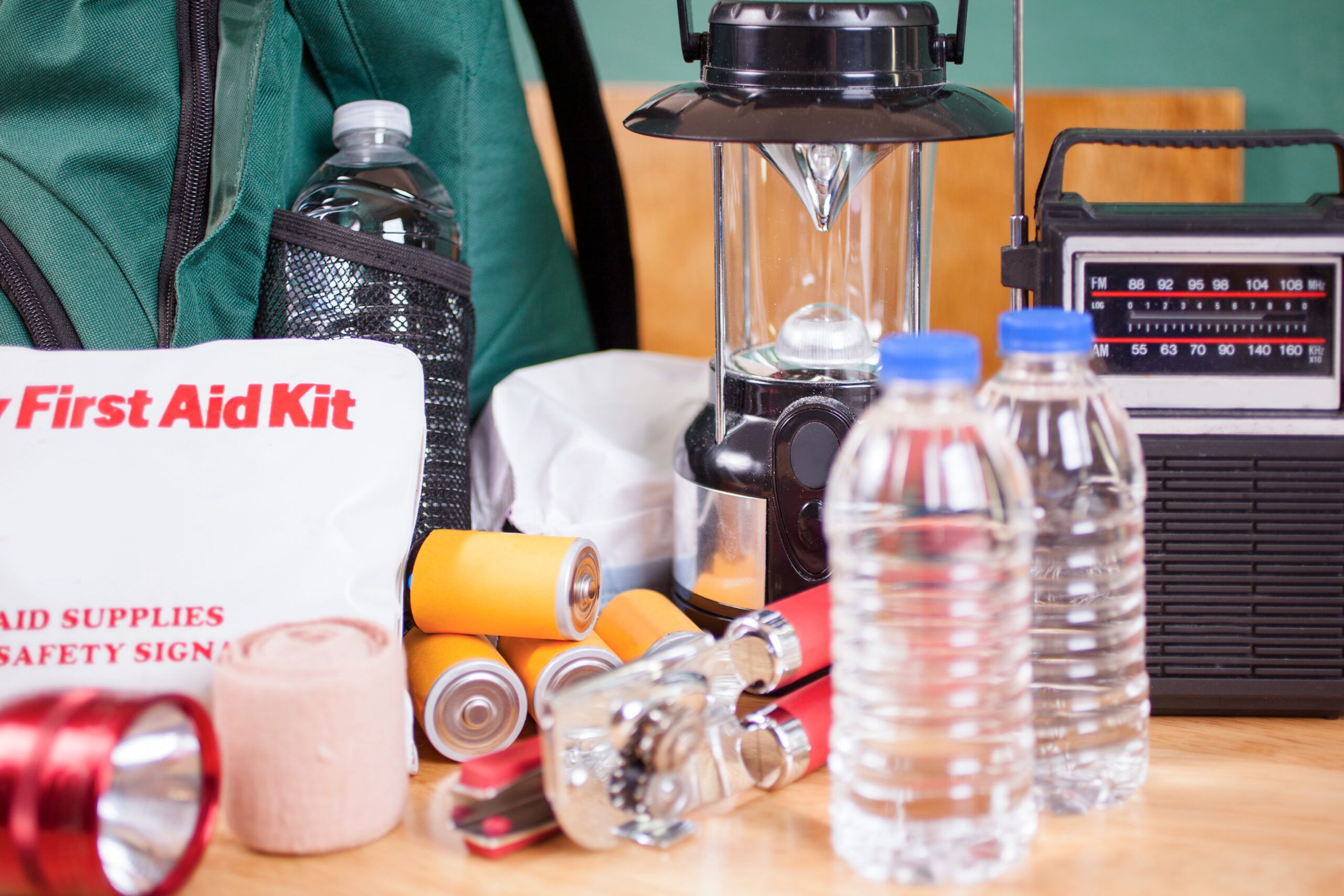
According to FEMA, if you are in a flood zone or at risk of a storm surge, head to the highest level of your house—but never go into a closed attic as this may leave you trapped as flood waters rise quickly. If you’ll be mostly hit by high winds with little potential of flooding, head to the lowest level of your house; for most folks that’s the basement, but the ground floor is also a good option. What’s important is to stay away from windows and doors—an interior room like a windowless bathroom, hallway, or closet is what’s recommended by emergency agencies. It could take a week or more for utilities to restore power to storm-lashed neighborhoods. Here are a few solutions to keep you rolling through the blackout.
Gather Non-Perishable Food and Water
There’s no telling what can happen with a hurricane, so it’s important to make sure there is enough food and water to get through the worst of it. Purchase food in cans as emergency supplies, as the containers can get wet without spoiling. (Don’t forget the can opener!) As for boxed food, consider transferring the contents to a plastic container so it will stay safe and dry. Also, make sure there is at least one gallon of water per person for per three days. Ensure you also have enough food and water for pets as well.
Power Up
A portable generator will pump out enough juice to power your fridge, freezer, and a few lights for several hours using gas. However, if gas pumps are shut down or flooded, a gas-powered generator won’t do much good. Consider a solar generator, which is essentially a large battery with solar panels. While solar input might be limited during the storm, the panels will absorb whatever light energy is available and convert it into electricity to power refrigerators, emergency devices, lights, cellphones, and even entertainment devices. You may also want to invest in an all-weather radio that, doesn’t require electricity or batteries to run, but is simply powered by a hand crank.
Acquire Water Pumps and Sandbags
A portable water pump can remove water from flooded areas. Sandbags can create barriers to divert water away from your home.
Keep a stock of sandbags and fill them ahead of the hurricane season to avoid the rush. Understand how to position sandbags effectively to create a solid barrier against floodwaters. Ensure your water pump has the necessary hoses and attachments to be deployed efficiently.
Install a Battery Backup Sump Pump
If you have a basement or crawl space, a battery backup sump pump can continue working even if the power goes out, preventing flooding and water damage.
Choose a sump pump with a high-capacity battery that can last long enough to handle extended power outages. Regularly test your sump pump system and replace the batteries as necessary. Install a water alarm to notify you of rising water levels, allowing you to act promptly.
Develop a Comprehensive Hurricane Plan
If you do need to evacuate, a well-thought-out plan can make all the difference when a hurricane threatens your area.
Establish an Evacuation Route
Know your area’s evacuation zones and routes. Plan multiple ways to leave your neighborhood in case certain roads become impassable. Identify safe places to stay, whether with family, friends, or at designated shelters.
Familiarize yourself with local emergency numbers and the locations of emergency services like hospitals and fire stations. Make sure your vehicle is filled with gas and a spare tire and emergency car kit are within easy reach. Practice your evacuation plan with all family members so everyone knows their roles and responsibilities.
Create a Communication Strategy
Develop a plan to stay in touch with family members:
- Designate an out-of-area contact everyone can call to check in.
- Learn how to send text messages, which may go through when phone calls don’t.
- Consider purchasing a battery-powered or hand-crank emergency radio for updates.
Establish check-in times to reduce panic and ensure that everyone knows when and how to report their status. Prepare a list of essential phone numbers written down in case electronic devices fail. Ensure all family members know how to operate the emergency radio and other communication tools.
Plan for Pet Safety
If you have pets, include them in your hurricane preparedness:
- Ensure they have proper identification.
- Pack pet food, water, and medications in your emergency kit.
- Research pet-friendly shelters or hotels along your evacuation route.
- Prepare a carrier or crate for your pet in case you need to transport them on short notice.
- Keep a recent photo of your pet to assist in identification if they get lost. Ensure your pet is microchipped and the information is current.
Understand and Update Your Insurance Coverage
Proper insurance coverage is crucial for recovering from hurricane damage.
Review Homeowners Insurance Policy
Carefully read your policy to understand what is and isn’t covered. Pay attention to deductibles and coverage limits for wind damage.
Seek clarification from your insurance agent if any aspects of your policy are unclear. Request annual reviews to ensure your coverage adapts to any changes in property value or specific needs. Maintain comprehensive records of all correspondence with your insurer.
Consider Flood Insurance
Standard homeowners’ policies typically don’t cover flood damage. If you live in a hurricane-prone area, consider purchasing separate flood insurance through the National Flood Insurance Program or a private insurer.
Evaluate different flood insurance options to find one that best suits your needs. Calculate the cost-benefit ratio based on your location’s historical flooding data. Understand the waiting periods for new policies to ensure you’re covered before the hurricane season starts.
Document Your Belongings
Create a detailed inventory of your possessions:
- Take photos or videos of each room in your home.
- List valuable items with their estimated worth.
- Store this information in a safe, easily accessible place.
Use a home inventory app to manage and update your records. Include serial numbers and purchase receipts for high-value items to expedite claims processes. Back up your inventory in a secure cloud service to ensure accessibility from anywhere.
